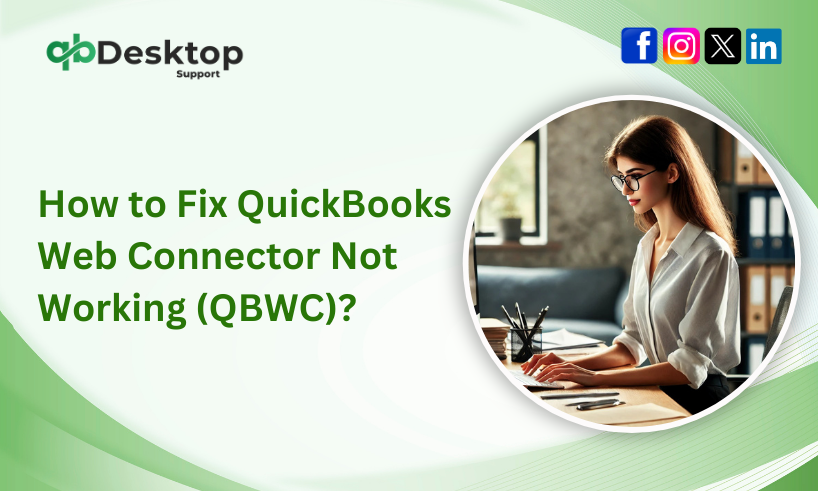QuickBooks Web Connector (QBWC) is a crucial tool that enables third-party applications to exchange data with QuickBooks Desktop products. However, users often encounter issues where QuickBooks Web Connector Not Working, leading to disruptions in workflow. This article provides an in-depth guide on the causes, solutions, and preventive measures to keep QuickBooks Web Connector functioning efficiently.
Understanding QuickBooks Web Connector
QuickBooks Web Connector is a Microsoft Windows application that facilitates data exchange between QuickBooks Desktop and online services. It uses SOAP-based web services to connect applications and sync data.
Key Functions of QuickBooks Web Connector:
- Automates data exchange between QuickBooks and third-party applications
- Supports multiple applications through an XML-based configuration
- Enhances business efficiency by reducing manual data entry
Common Issues with QuickBooks Web Connector
1. QuickBooks Web Connector Not Responding
One of the most frequently reported issues is that QBWC becomes unresponsive. Users might see an error message stating, “QBWC has stopped working,” or it might freeze during the syncing process.
2. Error Messages Displayed
Users often encounter error messages such as:
- “QBWC1085: There was a problem with the log file. QuickBooks Web Connector will continue without it.”
- “QBWC1005: An error occurred when connecting to QuickBooks.”
- “QBWC1048: Could not find application.”
- “QBWC1039: There was a problem adding the application.”
3. Web Connector Not Connecting to QuickBooks
In some cases, QuickBooks Web Connector fails to establish a connection with QuickBooks Desktop, preventing data synchronization.
4. Frequent Crashes and Performance Issues
Users report that QBWC crashes frequently or takes an unusually long time to process requests.
5. Sync Issues Between QuickBooks and Third-Party Applications
Data does not sync correctly between QuickBooks Desktop and third-party applications, causing discrepancies in records.
Also Read: How to Setup and Use QuickBooks Desktop Multi User Mode?
Causes of QuickBooks Web Connector Failure
Understanding the root causes of QuickBooks Web Connector issues can help in troubleshooting effectively. Some common causes include:
1. Corrupted or Outdated QuickBooks Web Connector
If the Web Connector files are corrupted or outdated, it may prevent the application from functioning correctly.
2. Incorrect Web Connector Configuration
Improper XML file setup or incorrect login credentials can cause connection failures.
3. Damaged or Missing QWC File
The .QWC file is essential for integrating third-party applications with QuickBooks. If this file is missing or damaged, QBWC may not work.
4. Firewall or Security Restrictions
Firewalls and antivirus software may block QuickBooks Web Connector from accessing the internet, leading to connection issues.
5. QuickBooks Not Running as Administrator
If QuickBooks is not running with administrative privileges, the Web Connector might not be able to establish a connection.
6. Windows Updates or System Changes
Certain Windows updates or modifications in system settings can interfere with QuickBooks Web Connector.
7. Third-Party Application Issues
Problems with the integrated third-party application may cause QuickBooks Web Connector errors.
How to Fix QuickBooks Web Connector Not Working?
1: Restart QuickBooks Web Connector
- Press Ctrl + Shift + Esc to open Task Manager.
- Locate QuickBooks Web Connector (QBWebConnector.exe).
- Right-click and select End Task.
- Reopen QuickBooks and restart the Web Connector.
2: Update QuickBooks Web Connector
- Download the latest version of QuickBooks Web Connector from Intuit’s official website.
- Uninstall the current version via Control Panel > Programs and Features.
- Install the updated version and restart your computer.
3: Run QuickBooks as Administrator
- Close QuickBooks and Web Connector.
- Right-click on the QuickBooks Desktop icon and select Run as Administrator.
- Open Web Connector and retry the connection.
4: Fix QBWC1085 Error (Log File Issue)
- Navigate to C:\ProgramData\Intuit\QBWebConnector\log.
- Rename the QWCLOG.TXT file to QWCLOG.OLD.
- Restart Web Connector and try again.
5: Reconfigure the .QWC File
- Open QuickBooks and navigate to File > App Management > Manage Web Apps.
- Locate the application and click Set Up.
- Follow on-screen instructions to download the new .QWC file.
- Open QuickBooks Web Connector and add the .QWC file.
6: Verify Firewall & Security Settings
- Open Windows Defender Firewall and go to Allow an App Through Firewall.
- Ensure that QBWebConnector.exe is listed and allowed.
- If blocked, click Change Settings and check both Private and Public options.
7: Repair QuickBooks Installation
- Press Windows + R and type appwiz.cpl, then press Enter.
- Locate QuickBooks in the program list.
- Click Uninstall/Change, then choose Repair.
- Follow on-screen instructions and restart the system.
8: Check Internet Connectivity
- Open Command Prompt (cmd) and type ping google.com.
- If there’s packet loss, reset your internet router.
- Ensure stable connectivity before using Web Connector.
9: Reinstall the Third-Party Application
- Uninstall the connected third-party app from Control Panel > Programs and Features.
- Download the latest version of the app from the vendor’s website.
- Install the app and reconfigure the Web Connector.
10: Check Windows Updates
- Press Windows + I to open Settings.
- Go to Update & Security > Windows Update.
- Click Check for Updates and install any pending updates.
- Restart your system and try running Web Connector again.
Preventive Measures to Avoid Web Connector Issues
1. Regularly Update QuickBooks and Web Connector
Always use the latest version of QuickBooks and Web Connector to avoid compatibility issues.
2. Keep .QWC Files Backed Up
Store copies of important .QWC files to quickly restore configurations if needed.
3. Configure Firewall and Security Software
Allow QuickBooks Web Connector through firewall settings to prevent connection issues.
4. Use a Stable Internet Connection
Ensure a high-speed and reliable internet connection to prevent sync failures.
5. Monitor Third-Party Integrations
Regularly check and update third-party applications connected via Web Connector.
6. Run QuickBooks with Admin Privileges
Always run QuickBooks as an administrator to allow smooth integration with Web Connector.
Also Read: How to Fix “QuickBooks Unable to Backup Company File”?
Conclusion
QuickBooks Web Connector plays a vital role in syncing data between QuickBooks Desktop and third-party applications. When it stops working, businesses may face disruptions. By understanding the causes and applying the troubleshooting steps outlined in this article, users can quickly restore functionality.
Regular maintenance, software updates, and best practices will ensure a seamless QuickBooks Web Connector experience. If issues persist, consulting a QuickBooks expert may be necessary to diagnose and resolve deeper system problems.
Frequently Asked Questions
QuickBooks Web Connector (QBWC) is a Microsoft Windows application that allows data exchange between QuickBooks Desktop and third-party web services. It automates data synchronization, eliminating the need for manual data entry.
If QBWC isn’t opening, it may be due to outdated software, missing system files, or corrupted installation. Try reinstalling the Web Connector and ensuring QuickBooks is updated.
The QBWC1085 error occurs when the log file (QBWebConnector.log) is corrupted or inaccessible. Deleting or renaming the log file and restarting Web Connector can resolve this issue.
If QBWC is stuck on “Loading Applications,” try the following:
1. Restart your computer.
2. Ensure the .QWC file is properly configured.
3. Delete and re-add the application in Web Connector.
This could be due to:
1. Incorrect firewall settings blocking the connection.
2. Expired security tokens or invalid authentication credentials.
3. A mismatch between the QuickBooks Desktop version and the Web Connector version.
The QBWC1039 error usually means the application certificate is not recognized. To fix it:
1. Ensure you have administrator rights.
2. Open QuickBooks as Admin and accept the certificate when prompted.
3. Verify that the .QWC file is properly formatted.
Frequent crashes may be due to:
1. Corrupt installation files—try reinstalling QBWC.
2. A Windows update conflicting with Web Connector.
3. Conflicting third-party applications—disable unnecessary startup programs.
Yes, but each computer must have the Web Connector installed and properly configured. The QuickBooks company file must also be accessible from each system using network-sharing settings.








